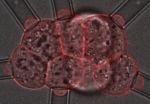Einstein saves the quantum cat
2015-06-16
(Press-News.org) This news release is available in German.
In 1915 Albert Einstein formulated the theory of general relativity which fundamentally changed our understanding of gravity. He explained gravity as the manifestation of the curvature of space and time. Einstein's theory predicts that the flow of time is altered by mass. This effect, known as "gravitational time dilation", causes time to be slowed down near a massive object. It affects everything and everybody; in fact, people working on the ground floor will age slower than their colleagues a floor above, by about 10 nanoseconds in one year. This tiny effect has actually been confirmed in many experiments with very precise clocks. Now, a team of researchers from the University of Vienna, Harvard University and the University of Queensland have discovered that the slowing down of time can explain another perplexing phenomenon: the transition from quantum behavior to our classical, everyday world.
How gravity suppresses quantum behavior
Quantum theory, the other major discovery in physics in the early 20th century, predicts that the fundamental building blocks of nature show fascinating and mind-boggling behavior. Extrapolated to the scales of our everyday life quantum theory leads to situations such as the famous example of Schroedinger's cat: the cat is neither dead nor alive, but in a so-called quantum superposition of both. Yet such a behavior has only been confirmed experimentally with small particles and has never been observed with real-world cats. Therefore, scientists conclude that something must cause the suppression of quantum phenomena on larger, everyday scales. Typically this happens because of interaction with other surrounding particles.
The research team, headed by ?aslav Brukner from the University of Vienna and the Institute of Quantum Optics and Quantum Information, found that time dilation also plays a major role in the demise of quantum effects. They calculated that once the small building blocks form larger, composite objects - such as molecules and eventually larger structures like microbes or dust particles -, the time dilation on Earth can cause a suppression of their quantum behavior. The tiny building blocks jitter ever so slightly, even as they form larger objects. And this jitter is affected by time dilation: it is slowed down on the ground and speeds up at higher altitudes. The researchers have shown that this effect destroys the quantum superposition and, thus, forces larger objects to behave as we expect in everyday life.
Paving the way for the next generation of quantum experiments
"It is quite surprising that gravity can play any role in quantum mechanics", says Igor Pikovski, who is the lead author of the publication and is now working at the Harvard-Smithsonian Center for Astrophysics: "Gravity is usually studied on astronomical scales, but it seems that it also alters the quantum nature of the smallest particles on Earth". "It remains to be seen what the results imply on cosmological scales, where gravity can be much stronger", adds ?aslav Brukner. The results of Pikovski and his co-workers reveal how larger particles lose their quantum behavior due to their own composition, if one takes time dilation into account. This prediction should be observable in experiments in the near future, which could shed some light on the fascinating interplay between the two great theories of the 20th century, quantum theory and general relativity.
INFORMATION:
Publication in Nature Physics:
"Universal decoherence due to gravitational time dilation". I. Pikovski, M. Zych, F. Costa, ?. Brukner.
Nature Physics (2015)
doi:10.1038/nphys3366
[Attachments] See images for this press release:

ELSE PRESS RELEASES FROM THIS DATE:
2015-06-16
The same kind of contraction that fires our muscles also controls a key stage of mammalian embryo development, according to a new study published in Nature Cell Biology. The research, conducted at EMBL Heidelberg, measured and mapped how cells in very early stage embryos bond tightly together. The scientists also discovered a cellular behaviour that hadn't been observed before: cells in the embryo 'dance', each one making the same rhythmic movement.
The focus of the study was a stage of development known as compaction, which takes place when the embryo has eight cells. ...
2015-06-16
In recent decades, enormous successes have been achieved in the field of public health. Three examples of these are the fight against HIV, the reduction in cardiovascular disease, and protection for non-smokers. For Germany to make even better use of the potential of public health, it needs more political support, improved research structures, and stronger international involvement. The German National Academy of Sciences Leopoldina, acatech - the National Academy of Science and Engineering, and the Union of the German Academies of Sciences and Humanities point this out ...
2015-06-16
Starfish have strange talents. Two biology students from University of Southern Denmark have revealed that starfish are able to squeeze foreign bodies along the length of their body cavities and out through their arm tips. This newly discovered talent gives insight into how certain animals are able to quickly heal themselves.
The two biology students, Frederik Ekholm Gaardsted Christensen and Trine Bottos Olsen have discovered a starfish behaviour that has never previously been described in the scientific literature. As part of their studies they were asked to tag some ...
2015-06-16
Chimpanzees and bonobos are the two closest living relatives of the human species - the ultimate tool-using ape. Yet, despite being so closely related on the evolutionary tree, wild chimpanzees and bonobos differ hugely in the way they use tools.
Chimpanzees show the most diverse range of tool use outside of humans. For example, chimpanzees use sticks to 'fish' for ants and termites, stones to crack nuts, as well as tools for grooming and communication. Bonobos rarely use tools and never to forage for food.
The question of 'what makes a tool user?' is a key one in ...
2015-06-16
AUSTIN, Texas -- Improving air quality -- in clean and dirty places -- could reduce pollution-related deaths worldwide by millions of people each year. That finding comes from a team of environmental engineering and public health researchers who developed a global model of how changes in outdoor air pollution could lead to changes in the rates of health problems such as heart attack, stroke and lung cancer.
Outdoor particulate air pollution results in 3.2 million premature deaths annually, more than the combined impact of HIV-AIDS and malaria. The researchers found that ...
2015-06-16
Lisbon, 16 June 2015: Despite a prevalence of anonymous sperm donation in European countries, the use of the same sperm donor for subsequent conceptions is of paramount importance to those couples needing sperm donation to have children. "We found a marked tendency to favour full genetic bonds where possible," said midwife Sara Somers presenting study results today at the Annual Meeting of ESHRE.
The study, performed by Ms Somers and colleagues at the Ghent University Hospital and Ghent University in Belgium, included 34 lesbian and heterosexual couples using sperm donation ...
2015-06-16
Lisbon, 16 June 2015: Dilatation and curettage (D&C) is one of the most common minor surgical procedures in obstetrics and gynaecology, used mainly for miscarriage or terminations.(1) Today, use of the 15-minute procedure is declining in favour of less invasive medical methods, but it still remains common in O&G.
Although D&C is generally considered safe and easy to perform, it is associated with some serious (if rare) side effects, including perforations to the cervix and uterus, infection, and bleeding. Now, an analysis 21 cohort studies which included almost 2 million ...
2015-06-16
Lisbon, 16 June 2015: It is a biological fact that female fertility declines with age - in assisted conception as in natural. Indeed, findings from a 12-year study reported today at the Annual Meeting of ESHRE by Dr Marta Devesa from the Hospital Universitaro Quiron-Dexeus in Barcelona, Spain, showed that in her own clinic cumulative live birth rates following IVF declined from 23.6% in women aged 38-39 years to 1.3% in those aged 44 and over.(1)
Such declines in success rate have been seen in many studies, but are not evident in older patients having egg donation to ...
2015-06-16
Lisbon, 16 June 2015: The risk of ectopic pregnancy following fertility treatment with assisted reproduction (ART) is small but significantly higher than found in natural conceptions. Now, a nationwide population-based analysis of all ART pregnancies achieved in the UK between 2000 and 2012 has found that the rate of ectopic pregnancy following IVF and ICSI progressively decreased throughout these 12 years, almost halving from an overall rate of 20 to 12 cases per thousand.
The results of the study are presented today at the Annual Meeting of ESHRE in Lisbon by Professor ...
2015-06-16
New research from the University of Copenhagen has found that maintaining a good night's sleep is important for our future health, partly because of how it affects lifestyle factors. Previous population based studies have not provided sufficient information on the timing of changes in both sleep and lifestyle to tease out cause and effect relations of this highly intertwined relationship.
"This study shows that sleep affects our ability to maintain a healthy lifestyle, and when sleep deteriorates we are more likely to make unhealthy lifestyle changes," says Postdoc Alice ...
LAST 30 PRESS RELEASES:
[Press-News.org] Einstein saves the quantum cat



